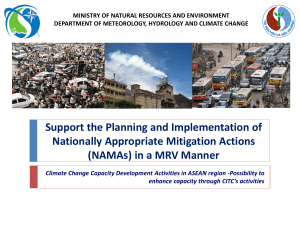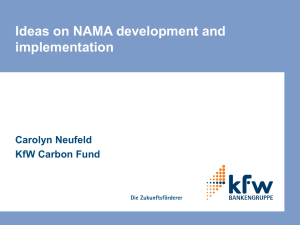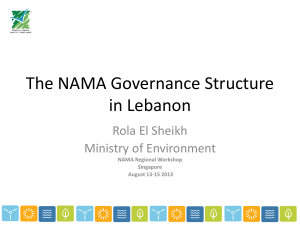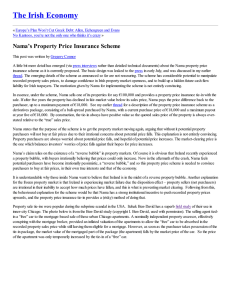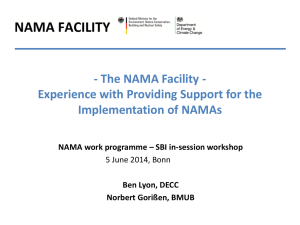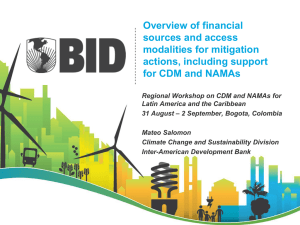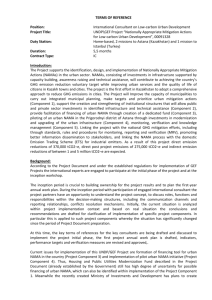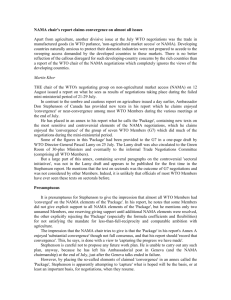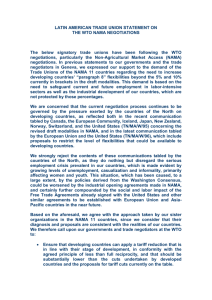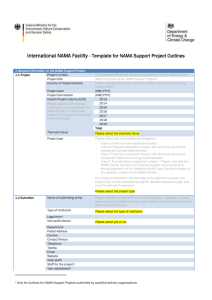Template_NAMA
advertisement
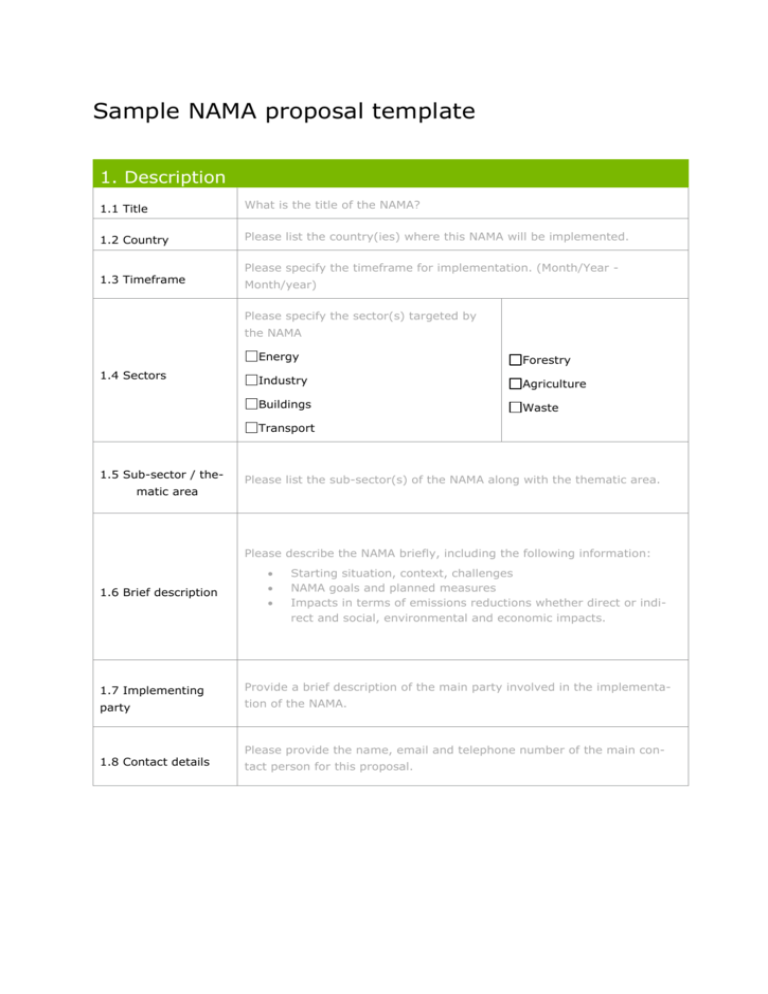
Sample NAMA proposal template 1. Description 1.1 Title What is the title of the NAMA? 1.2 Country Please list the country(ies) where this NAMA will be implemented. 1.3 Timeframe Please specify the timeframe for implementation. (Month/Year Month/year) Please specify the sector(s) targeted by the NAMA 1.4 Sectors Energy Forestry Industry Agriculture Buildings Waste Transport 1.5 Sub-sector / thematic area Please list the sub-sector(s) of the NAMA along with the thematic area. Please describe the NAMA briefly, including the following information: 1.6 Brief description Starting situation, context, challenges NAMA goals and planned measures Impacts in terms of emissions reductions whether direct or indirect and social, environmental and economic impacts. 1.7 Implementing Provide a brief description of the main party involved in the implementa- party tion of the NAMA. 1.8 Contact details Please provide the name, email and telephone number of the main contact person for this proposal. 2. Context and strategic assessment This section establishes the rationale for supporting the NAMA by describing the business-as-usual situation as well as the national priorities for greenhouse gas (GHG) emission reductions. 2.1 National and inter- Briefly describe the current framework for addressing climate change in the target country (ies). Specify how this relates to international agreements, especially in relation to emission reduction pledges. national climate policy context Please indicate the sector(s) targeted by the NAMA and explain its contribution to the national GHG balance. Include sources and figures when necessary. 2.2 Context of the sector within national emissions priorities. If the country has a Low Emissions Development plan or strategy, please specify it here. 3. Proposed activities This section provides a description of the project objective and proposed activities . Please describe the overarching objective of the NAMA. 3.1 Overarching objective 2 3.3 Activities, outputs and outcomes List specific activities to be undertaken as part of the NAMA and describe the expected outputs and outcomes. Outputs occur within the project boundaries, are achieved by the project directly and can be monitored. Outcomes are the consequences of outputs of the project. They describe the effects of the project on its environment, in other words on partners, intermediaries and the target group. Add more rows below if necessary Time Activity Expected outputs Example: Introduce labelling scheme through voluntary agreements with manufacturers and distributors of electric motors and drives. Example: Electric motors sold after 2016 display an energy efficiency label in accordance to international standards. Example: Establish an awareness campaign: “Achieving energy efficiency through Electric Motors”) Example: Inform 2000 Small and Medium Sized Enterprises (SMEs) on the importance of motor management through public awareness campaign. Example: Energy management training for plant operators and purchasing managers. Example: Train 3000 operators and purchasing managers on energy management, providing them the tools and knowledge to assess the energy footprint of their facilities. Example: Launch soft loan programme to support projects that invest in energy efficient motors in partnership with local financial institutions. Example: Disburse $100 million in subsidized loans through local financial institutions for EEM projects. frame 3 Outcomes 2014-2016 Example: Consumers have an easy way to compare energy efficiency of motors and consider lifetime operating costs in purchasing decisions. 2013-2017 Example: SME managers discover the benefits of investing in energy efficient motors (EEMs) and consider lifetime operating costs in a purchasing decision. 2013-2017 Example: Plant operators and managers are aware of the energy footprints of installations they manage and the options available to reduce energy use. 2014-2017 Example: Improved access to capital for EEM projects; local financial institutions are familiar with origination and management of EEM loans. 4 Measurement, Reporting and Verification (MRV) This section specifies the MRV approach for the NAMA. The MRV framework if composed of a set of indicators that measure progress in reaching the objectives of the NAMA and details on how these would be measured, reported and verified. Indicators are quantitative or qualitative variables that are subject to change in the course of a project. It is this change which represents the results of the project. Indicators add greater precision to the project goals and serve as a binding standard for measuring the attainment of goals and thus the success of the project. Please state the indicators that shall be used to monitor the project specified by activities as listed in Table 5.4. Activity Key Indicators (outputs and outcomes) Frequency of measurement Responsible entity 4.1 Key indicators and interim results Add more rows if necessary 4.2 Reporting Please provide additional details of how progress and results will be reported. 4 4.3 Verification Please provide additional details of how verification will be performed, both internally and externally. 5. Impacts and costs 5.1 Impacts 5.1.1 Overview of NAMA impacts and Please provide a brief summary of expected project impacts in terms of GHG emission reductions and other impacts. How do these impacts align with climate, environmental and economic development priorities in the target country(ies)? target groups Please indicate the best-estimate for cumulative GHG emission reductions (tCO2-e) as a direct result of the activities within the NAMA. Detailed calculations, sources and figures should be included separately. Add rows when necessary Year Cumulative tCO2-e Year 1 5.1.2 Direct emission reductions Year 2 Year 3 Year 4 Add more rows if necessary Total sum Sum 5 5.1.3 Impacts on mitigative capacity The mitigative capacity of a country relates to its ability to reduce greenhouse gas emissions or maintain natural (carbon) sinks. Particular ways in which this capacity can be increased are (1) developing human resources, (2) developing organisations, (3) cooperation and network-building, and (4) developing policy fields and frameworks for institutions. emission impacts. Please describe how the NAMA would contribute to increasing the mitigative capacity of the target country and sector. Describe the cause-and-effect relationship of how changes in mitigative capacity might lead to (indirect) emissions impacts. 5.1.4 Social im- Please provide a qualitative and/ or quantitative estimation of expected social benefits of the proposed NAMA. Indicate the target groups that are expected to benefit from the project. Please indicate in bullet points. and other indirect pacts 5.1.5 Economic impacts 5.1.6 Environmental impacts 5.2 Please provide a qualitative and/ or quantitative estimation of expected economic benefits of the proposed NAMA. Indicate the target groups that are expected to benefit from the project. Please indicate in bullet points. Please provide a qualitative and/ or quantitative estimation of expected environmental benefits of the proposed NAMA. Please indicate in bullet points. Costs (provide detailed calculations separately) 6 Using the activities specified in 3.3, please indicate the total cost (in €) and the funds requested. Add rows when necessary. Activity Total cost 3rd party financing Requested NAMA financing sum sum sum 5.2.1 Cost breakdown Add more necessary rows if Totals 7






